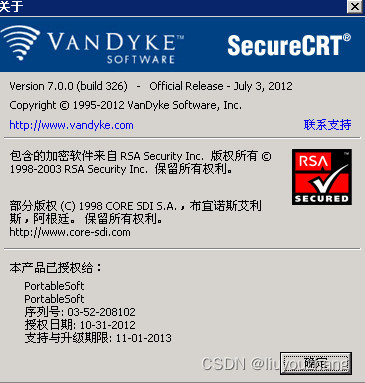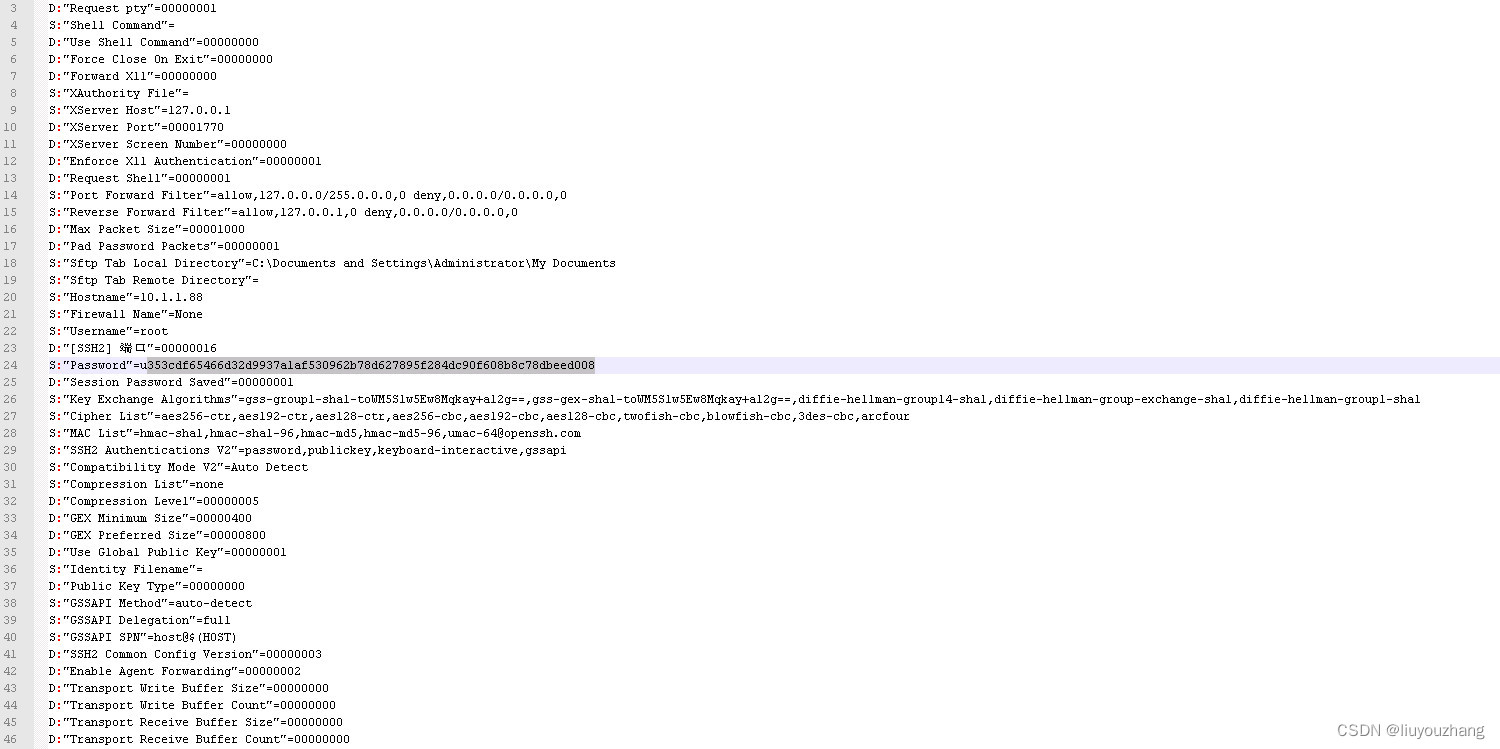SecureCRT登录会话密码解密_securecrt密码解密-程序员宅基地
技术标签: python
此文章是针对忘记了SecureCRT登录时输入的密码,选择了保存密码,后面忘记了密码,需要通过SecureCRT的密码保存记录,恢复找回机器登录密码的情况。
以下为我的操作步骤,特此记录,以备忘。
环境:Python3.7,win10 64位,PyCharm2020.1
由于解密的代码,用到了python的crypto这个库,因此需要先安装。注意下面pycryptodome,就是windows平台的安装的软件名称,不用怀疑,安装了这个就可以了。
安装pycrypto,pip install pycryptodome (windows平台是这个)

打开SecureCRT软件,依次打开 选项->全局选项->常规->配置文件夹,可以看到会话保存文件,每个文件名称以保存时的会话名称命名,找到需要解密的会话对应的文件,用文本编辑软件打开。

打开各IP地址对应的会话的登录配置信息文件(.ini结尾),如下位置,可以看到密码的密文 ,这里我们的SecureCRT是7.0的版本,密文前面带一个字母u前缀,把前缀去掉,拷贝后面的一串密文。 注意不同的SecureCRT版本,这里的密文的前缀可能不同。
 在PyCharm中,打开控制台命令行,运行
在PyCharm中,打开控制台命令行,运行
python SecureCRTDecrypt.py dec "353cdf65466d32d9937a1af530962b78d627895f284dc90f608b8c78dbeed008" (python37_env01) C:\Users\mythinkpadpc\PycharmProjects\pythonProject\SecureCRT>python SecureCRTDecrypt.py dec "353cdf65466d32d9937a1af530962b78d627895f284dc90f608b8c78dbeed008"
(输出密码明文)root.88
即可在控制台看到输出结果。
付完整代码,方便没梯子的同学:
#!/usr/bin/env python3
import os
from Crypto.Hash import SHA256
from Crypto.Cipher import AES, Blowfish
class SecureCRTCrypto:
def __init__(self):
'''
Initialize SecureCRTCrypto object.
'''
self.IV = b'\x00' * Blowfish.block_size
self.Key1 = b'\x24\xA6\x3D\xDE\x5B\xD3\xB3\x82\x9C\x7E\x06\xF4\x08\x16\xAA\x07'
self.Key2 = b'\x5F\xB0\x45\xA2\x94\x17\xD9\x16\xC6\xC6\xA2\xFF\x06\x41\x82\xB7'
def Encrypt(self, Plaintext: str):
'''
Encrypt plaintext and return corresponding ciphertext.
Args:
Plaintext: A string that will be encrypted.
Returns:
Hexlified ciphertext string.
'''
plain_bytes = Plaintext.encode('utf-16-le')
plain_bytes += b'\x00\x00'
padded_plain_bytes = plain_bytes + os.urandom(Blowfish.block_size - len(plain_bytes) % Blowfish.block_size)
cipher1 = Blowfish.new(self.Key1, Blowfish.MODE_CBC, iv=self.IV)
cipher2 = Blowfish.new(self.Key2, Blowfish.MODE_CBC, iv=self.IV)
return cipher1.encrypt(os.urandom(4) + cipher2.encrypt(padded_plain_bytes) + os.urandom(4)).hex()
def Decrypt(self, Ciphertext: str):
'''
Decrypt ciphertext and return corresponding plaintext.
Args:
Ciphertext: A hex string that will be decrypted.
Returns:
Plaintext string.
'''
cipher1 = Blowfish.new(self.Key1, Blowfish.MODE_CBC, iv=self.IV)
cipher2 = Blowfish.new(self.Key2, Blowfish.MODE_CBC, iv=self.IV)
ciphered_bytes = bytes.fromhex(Ciphertext)
if len(ciphered_bytes) <= 8:
raise ValueError('Invalid Ciphertext.')
padded_plain_bytes = cipher2.decrypt(cipher1.decrypt(ciphered_bytes)[4:-4])
i = 0
for i in range(0, len(padded_plain_bytes), 2):
if padded_plain_bytes[i] == 0 and padded_plain_bytes[i + 1] == 0:
break
plain_bytes = padded_plain_bytes[0:i]
try:
return plain_bytes.decode('utf-16-le')
except UnicodeDecodeError:
raise (ValueError('Invalid Ciphertext.'))
class SecureCRTCryptoV2:
def __init__(self, ConfigPassphrase: str = ''):
'''
Initialize SecureCRTCryptoV2 object.
Args:
ConfigPassphrase: The config passphrase that SecureCRT uses. Leave it empty if config passphrase is not set.
'''
self.IV = b'\x00' * AES.block_size
self.Key = SHA256.new(ConfigPassphrase.encode('utf-8')).digest()
def Encrypt(self, Plaintext: str):
'''
Encrypt plaintext and return corresponding ciphertext.
Args:
Plaintext: A string that will be encrypted.
Returns:
Hexlified ciphertext string.
'''
plain_bytes = Plaintext.encode('utf-8')
if len(plain_bytes) > 0xffffffff:
raise OverflowError('Plaintext is too long.')
plain_bytes = \
len(plain_bytes).to_bytes(4, 'little') + \
plain_bytes + \
SHA256.new(plain_bytes).digest()
padded_plain_bytes = \
plain_bytes + \
os.urandom(AES.block_size - len(plain_bytes) % AES.block_size)
cipher = AES.new(self.Key, AES.MODE_CBC, iv=self.IV)
return cipher.encrypt(padded_plain_bytes).hex()
def Decrypt(self, Ciphertext: str):
'''
Decrypt ciphertext and return corresponding plaintext.
Args:
Ciphertext: A hex string that will be decrypted.
Returns:
Plaintext string.
'''
cipher = AES.new(self.Key, AES.MODE_CBC, iv=self.IV)
padded_plain_bytes = cipher.decrypt(bytes.fromhex(Ciphertext))
plain_bytes_length = int.from_bytes(padded_plain_bytes[0:4], 'little')
plain_bytes = padded_plain_bytes[4:4 + plain_bytes_length]
if len(plain_bytes) != plain_bytes_length:
raise ValueError('Invalid Ciphertext.')
plain_bytes_digest = padded_plain_bytes[4 + plain_bytes_length:4 + plain_bytes_length + SHA256.digest_size]
if len(plain_bytes_digest) != SHA256.digest_size:
raise ValueError('Invalid Ciphertext.')
if SHA256.new(plain_bytes).digest() != plain_bytes_digest:
raise ValueError('Invalid Ciphertext.')
return plain_bytes.decode('utf-8')
if __name__ == '__main__':
import sys
def Help():
print('Usage:')
print(' SecureCRTCipher.py <enc|dec> [-v2] [-p ConfigPassphrase] <plaintext|ciphertext>')
print('')
print(' <enc|dec> "enc" for encryption, "dec" for decryption.')
print(' This parameter must be specified.')
print('')
print(' [-v2] Encrypt/Decrypt with "Password V2" algorithm.')
print(' This parameter is optional.')
print('')
print(' [-p ConfigPassphrase] The config passphrase that SecureCRT uses.')
print(' This parameter is optional.')
print('')
print(' <plaintext|ciphertext> Plaintext string or ciphertext string.')
print(' NOTICE: Ciphertext string must be a hex string.')
print(' This parameter must be specified.')
print('')
def EncryptionRoutine(UseV2: bool, ConfigPassphrase: str, Plaintext: str):
try:
if UseV2:
print(SecureCRTCryptoV2(ConfigPassphrase).Encrypt(Plaintext))
else:
print(SecureCRTCrypto().Encrypt(Plaintext))
return True
except:
print('Error: Failed to encrypt.')
return False
def DecryptionRoutine(UseV2: bool, ConfigPassphrase: str, Ciphertext: str):
try:
if UseV2:
print(SecureCRTCryptoV2(ConfigPassphrase).Decrypt(Ciphertext))
else:
print(SecureCRTCrypto().Decrypt(Ciphertext))
return True
except:
print('Error: Failed to decrypt.')
return False
def Main(argc: int, argv: list):
if 3 <= argc and argc <= 6:
bUseV2 = False
ConfigPassphrase = ''
if argv[1].lower() == 'enc':
bEncrypt = True
elif argv[1].lower() == 'dec':
bEncrypt = False
else:
Help()
return -1
i = 2
while i < argc - 1:
if argv[i].lower() == '-v2':
bUseV2 = True
i += 1
elif argv[i].lower() == '-p' and i + 1 < argc - 1:
ConfigPassphrase = argv[i + 1]
i += 2
else:
Help()
return -1
if bUseV2 == False and len(ConfigPassphrase) != 0:
print('Error: ConfigPassphrase is not supported if "-v2" is not specified')
return -1
if bEncrypt:
return 0 if EncryptionRoutine(bUseV2, ConfigPassphrase, argv[-1]) else -1
else:
return 0 if DecryptionRoutine(bUseV2, ConfigPassphrase, argv[-1]) else -1
else:
Help()
exit(Main(len(sys.argv), sys.argv))参考:
2、(150条消息) 找回SecureCRT密码_itinns_007的博客-程序员宅基地_securecrt忘记密码
3、【转】找回 SecureCRT的密码 - 耕读编码 - 博客园 (cnblogs.com)
参考的这3个文章,我都试过,可能是这些都是python2的,反正都用不了。
SecureCRT其他版本,此程序不一定适用,以上仅仅是我在SecureCRT 7.0上亲自验证可使用的。
智能推荐
多线程基础之设计模式Future模式_线程 future-程序员宅基地
文章浏览阅读258次。多线程基础之设计模式Future模式_线程 future
CCS中关于error#5、error#10008-D、error#16001的更正指导_cannot find file "libc.a-程序员宅基地
文章浏览阅读1w次,点赞17次,收藏60次。本文档仅对ccs编程过程中所出现的error#5、error#10008-D、error#10010做简要讲解在使用ccs对dsp编程过程中,用户可能会参考一些例程或在维护优化时阅读他人程序,而在导入程序时会出现各种各样的错误或警告,下面对编者在修改程序时遇到的error#5、error#10008-D和error#10010做简要讲解。1.error#5的错误更正讲解在ccs中导入其..._cannot find file "libc.a
poj 3080(3450) KMP(暴力也能过) 多个串的最长公共子串-程序员宅基地
文章浏览阅读359次。题意:给定m(m思路:暴力找出第一个串的所有长度大于等于3的子串,用KMP算法求其是否为剩下m-1个串的子串。为了复用next数组,枚举子串时先固定起点(求一遍next数组即可),然后由长到短枚举子串(剪枝)。#include #include using namespace std;#define N 60char s[12][N+5],t[N+5],res[N+5];int
matlab reshape意义,matlab reshape使用-程序员宅基地
文章浏览阅读1.4k次。reshape把指定的矩阵改变形状,但是元素个数不变,例如,行向量:a = [1 2 3 4 5 6]执行下面语句把它变成3行2列:b = reshape(a,3,2)执行结果:b =1 42 53 6若a=[1 2 34 5 67 8 9]使用reshpe后想得到b=[1 2 3 4 5 6 7 8 9]只需要将a转置一下就可以了:b=reshape(a',1,9)---------------..._matlab中reshape的含义
c语言中数学运算符,运算符在数学和C语言中的区别.doc-程序员宅基地
文章浏览阅读1k次。运算符在数学和C语言中的区别刚开始学C语言的人,一般都认为C语言中的运算符跟数学中的运算符完全相同,没必要去考虑和研究,从而在利用过程中经常出错而把学习C语言越来越难或神秘化,其实学C语言并不是很难的事,要把握有些重要技巧,很容易学会.著名计算机科学家沃思(Nikiklaus Wirth)说“程序=算法+数据类型”,要好好学会程序,首先要深入了解算法,而了解算法事实上指的是就是正确地了解和利用运算..._c语言中的加减乘除和数学中的加减乘除有什么不同【
SSM三大框架Spring_后端框架三大框架-程序员宅基地
文章浏览阅读3.9k次。一、三大框架基本结构1.为什么需要框架说明: 如果生产环境下的项目,都是从头(从底层写起)开发,难度太大了,并且开发的效率极其低下. 所以为了让项目快速的上线部署. 将某些特定的功能.进行了高级的封装. 那么我们如果需要使用封装后的API.,则必须按照人家的要求编码2.框架的分类:1.Spring框架:整个框架中负责“宏观调控”的(主导),负责整合其它的第三方的框架2.SpringMVC框架:主要负责实现前后端数据的交互3.Mybatis框架/MybatisPlus框架:持久层框.._后端框架三大框架
随便推点
数据结构(3):java使用数组模拟堆栈-程序员宅基地
文章浏览阅读2次。 堆栈原理: 数组模拟堆栈: //数组模拟栈class ArrayStack{ //栈顶 private int top = -1; private int maxSize; private int[] arrayStack; public ArrayStack(int maxSize){ this.maxSi...
Understand_6.5.1175::New Project Wizard_understand 6.5.1176-程序员宅基地
文章浏览阅读742次,点赞16次,收藏17次。不选: Enforce portability rules to share this project with others。勾选: Configure Advanced Settings after project creation。保存类型(T):Understand projects (*.udb)勾选:Include subdirectories (包含子文件夹)Additional Filters: (空)单击 文件夹 lab1。文件名(N):lab1。双击 文件夹 boot。_understand 6.5.1176
从零开始带你成为MySQL实战优化高手学习笔记(二) Innodb中Buffer Pool的相关知识_mysql_global_status_innodb_buffer_pool_reads-程序员宅基地
文章浏览阅读969次。在从零开始带你成为MySQL实战优化高手学习笔记(一)中学习到一条语句到底是怎么执行的,从链接获取数据到通过查询解析器解析SQL语句表达的什么意思,解析之后由查询优化器生成查询路径树,选出一条最优查询路径调用存储引擎接口..._mysql_global_status_innodb_buffer_pool_reads
美化上传文件框(上传图片框)_文件上传框很丑-程序员宅基地
文章浏览阅读8.8k次,点赞6次,收藏12次。传统的表单控件十分简陋,可以说是很难看,那怎么办?方法:我们自己做一个好看的样式出来,用各种标签啊,css啊,是可以做到的。如图:做出这样一个样子应该是很简单的,但是怎么让他具有上传的功能的呢?那就使用代理的方法,点击上传就等于点击(上传文件表单控件)废话不多说,直接上代码:html:测试插件body{font_文件上传框很丑
js简单表格操作_"var str = '<table border=\"5px\"><tr><td>序号</td><-程序员宅基地
文章浏览阅读4.8k次,点赞3次,收藏18次。js简单表格操作,对表格进行增删改,效果图:全部代码:<!DOCTYPE html><html><head> <meta charset="utf-8" /> <script type="text/javascript" src="js/jquery.2.1.4.min.js" ></sc_"var str = '序号名字
Power BI销售数据分析_powerbi汇总销售人员业绩包括无销售记录的人-程序员宅基地
文章浏览阅读1.1w次,点赞8次,收藏99次。今天通过一份销售数据,聊聊Power BI数据分析。一、分析数据数据源总的有四个表,店铺资料,销售目标,销售数据_本期,销售数据_去年同期。各表表头如下:1店铺资料表:2销售目标:3销售数据_本期:4销售数据_去年同期:数据中包含多个城市、督导、店铺的数据,我希望经过分析后能得到各个城市/店铺的销售情况,即业绩、业绩完成率、业绩贡献度、业绩增长率、各销售人员的销售能力等。此次..._powerbi汇总销售人员业绩包括无销售记录的人